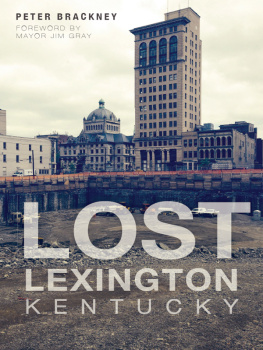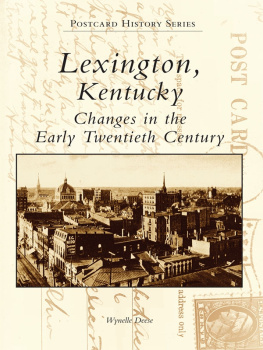
Published by The History Press
Charleston, SC 29403
www.historypress.net
Copyright 2014 by Peter Brackney
All rights reserved
Front cover: Authors Collection.
First published 2014
e-book edition 2014
ISBN 978.1.62585.128.4
Library of Congress Cataloging-in-Publication Data
Brackney, Peter.
Lost Lexington, Kentucky / Peter Brackney ; foreword by Mayor Jim Gray
pages cm
Includes bibliographical references and index.
print edition ISBN 978-1-62619-599-8 (paperback)
1. Historic sites--Kentucky--Lexington. 2. Historic buildings--Kentucky--Lexington. 3. Lexington (Ky.)--History. 4. Lexington (Ky.)--Buildings, structures, etc. 5. Fayette County (Ky.)--History, Local. I. Title.
F459.L6B73 2014
976.947--dc23
2014036060
Notice: The information in this book is true and complete to the best of our knowledge. It is offered without guarantee on the part of the author or The History Press. The author and The History Press disclaim all liability in connection with the use of this book.
All rights reserved. No part of this book may be reproduced or transmitted in any form whatsoever without prior written permission from the publisher except in the case of brief quotations embodied in critical articles and reviews.
This book is dedicated to my parents, who fostered my love for history, and to my wife, who must endure it.
CONTENTS
FOREWORD
In the nearly two and a half centuries since Lexington was founded in 1775, this once-frontier settlement has grown into a flourishing city of more than 300,000 residents. It has produced some remarkable landmarks and people. These entrepreneurs, intellectuals and civic leaders had the imagination and vision that helped make Lexington what it is today: a city that embraces new ideas and innovation while valuing its rural landscape and authentic past.
The story of how Lexington has evolved to its present-day landscape is a story of balancing preservation and progress. Philosophies, priorities and ideas changefor better or for worse. And of course, Lexingtons architecture and landscape have reflected those changes.
In Lost Lexington, Peter Brackney highlights several sites that, for a variety of reasons, did not survive as the city grew. Brackneys work explores structures that were lost over a century ago, as well as more modern buildings and attractions, of which many readers will have personal memories and recollections.
Reflecting on Lexingtons architectural journey is a meaningful exercise. Drawing upon Brackneys fascinating research, we can see these stories as important lessons for the way forward. As Lexington continues to reinvent itself, it is the citys unique and rich past that will inform and inspire its future.
JIM GRAY
Mayor of Lexington
PREFACE
Though not a native Kentuckian, I have called central Kentucky home since I was in the first grade. I grew up in a fine old house in downtown Lexingtons Historic Western Suburb; while living here, I discovered my passion for history.
The most recent section of my childhood home was built by John McMurtry in 1843. It is full of personal memories for me, but the house also played a larger role in a bigger world. Erected in stages, the house reached to the early annals of the Western Suburbs existence. The neighborhood was Lexingtons first, and it witnessed some of the citys most interesting events and most notorious characters. The City of Lexington, once the Athens of the West, was instrumental in our nations westward expansion.
Despite the strong, and quite literal, foundation in history, I never pursued the liberal arts during college, yet my passion for history never waned. Still, my early upbringing in a Civil Warthemed room and my love of history-related family trips found me embracing history. To paraphrase the great Kentucky journalist Al Smith, History is in the genes. And I have that history gene.
In learning about Kentuckys past, whether its people, places or events, I have discovered so many threads that weave through our Commonwealths history. It never ceases to amaze me how those common threads reemerge as Im researching a different subject in Kentuckys history. A common place or a shared ancestor or business partner will link stories when least expected. This is certainly the case in Lost Lexington, where characters and places in one chapter reemerge in another. Some of these links are immediately apparent, while others are subtler.
Whether you attribute the old quote to an old Baptist preacher or to Daniel Boone himself does not matter, for the maxim is still true: Heaven must be a Kentucky of a place. People often wonder what heaven will be like. We often ask with whom wed like to engage once we arrive at the Pearly Gates. Whether an old friend or a fascinating individual from the past, we want to learn more about their lives, their families and the places theyve been. So it is with studying Kentuckys past.
And these interwoven stories of Kentuckys history are truly heavenly. Yes, I believe it is so: Heaven must be a Kentucky of a place. But we are losing part of that heaven as buildings are demolished and green space is lost. And while the structures described in this book may be gone, these connections should not be forgotten. This book serves as a reminder of what once was.
ACKNOWLEDGEMENTS
There are so many people who played a role in this book. But first, I must give my thanks to the love of my life, Morganne, and to our children, who offered me so many hours (both uninterrupted and interrupted) of time to write.
Then there are all of those who directly assisted with the research, the writing or the editing. Ive bounced ideas off of you and learned that several of my ideas had no bounce. To each, I say thank you!
In the time-honored tradition of alphabetical order, my thanks go out to Rachel Alexander, Bill Ambrose, Peter Bourne, Becky Eblen, Yvonne Giles, Nate Kissel, Kirsten Minnie, Marty Perry, Jason Sloan and Debra Watkins. Each tremendously helped in some way with the preparation of this text.
Many thanks to the organizations that have provided materials for research, for the use of images and for being committed to preserving and sharing our history. Specifically, those at the Blue Grass Trust for Historic Preservation, LexHistory (formerly the Lexington History Museum), the Kentucky Heritage Council and the University of Kentucky. To each involved, thank you!
And to my hometown of Lexington: you are awesome! I love this community from the downtown core to the inner ring neighborhoods to the bedroom communities outside of Fayette County. All of this is a part of Lexington, a vibrant and living community for almost 240 years!
INTRODUCTION
An architect whose work features prominently in Lexington once said, architecture has been called the art of building beautifully, a fixation of mans thinking, and record of his activity. But what happens when that record is lost?
Architecture, through buildings, can provide us with tangible reminders of people, places and events. Buildings themselves can trigger memories. Each building has a story that contributes to our human history. Though many find history and its preservation to be an unnecessary exercise, I would suggest that we must understand and preserve our history in order to better understand ourselves. Lost Lexington merely cracks the surface of what has been lost to history. Each loss has been prompted by a different cause. Whether a government policy, a private development, an arsonists hand, pure spite or an act of God, Lexington has been and will continue to be changed from what was, what is and what is to come.
Next page












